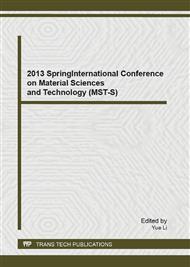p.189
p.195
p.200
p.207
p.212
p.220
p.229
p.235
p.241
Study of Hybrid Photovoltaic Materials with Poly(3-Hexylthiophene) and CdS Nanoparticles by Spectroscopic Techniques
Abstract:
Poly (3-hexylthiophene) (P3HT) was synthesized via chemical oxidative reaction at room temperature with anhydrous ferric chloride as oxidant. The hybrid films of P3HT were prepared by doping inorganic semiconductor nanoparticles of CdS. Fourier transform infrared (FT-IR) spectrum, UV-vis, fluorescence and resonance light scattering (RLS) spectra were applied to characterize the photophysical properties of P3HT and doped polymer. The results indicated that the infrared absorbance of hybrid films increased with the increase of doped CdS content. The intensity of UV absorption presented a slight increase, the blend spectra were simply the sum of the absorptions of the constituent parts of the composite solution. With the addition of CdS nanoparticles, the emission peak of P3HT was shifted to longer wavelengths. The shift from 543 to 567 nm was due to the fluorescence resonance energy transfer between CdS nanoparticles and P3HT, and then the red-shift from 567 to 573 nm was caused by the agglomeration of CdS nanoparticles. RLS spectra revealed that the maximum scattering wavelength of systems initially showed a blue-shift, and then exhibited a pronounced red-shift with the addition of CdS nanoparticles. These findings provided insights into the role of spectroscopic techniques in studying the photophysical properties of composites. Our further work is toward investigating the mechanism and dynamic process of exciton interaction between polymers and inorganic semiconductor nanoparticles.
Info:
Periodical:
Pages:
212-219
Citation:
Online since:
June 2013
Price:
Сopyright:
© 2013 Trans Tech Publications Ltd. All Rights Reserved
Share:
Citation:


